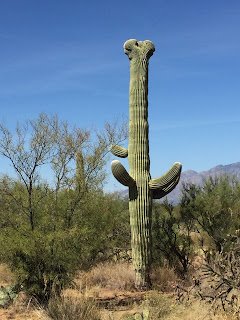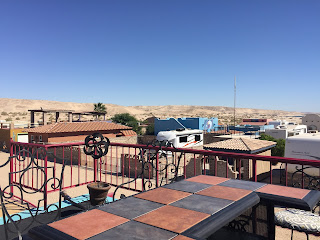On the Road Again - Part 2
Tucson is a rather lovely city. It
nestles at the bottom of Mount Lemmon, and between two sections of
the Sonoran Desert that hosts the multi armed cacti known as Saguaro.
You know, those cacti you first saw in old westerns, a great many of
which were filmed in Tuscson. You might find it fun to check out the
numbers of films that were shot in Arizona over the years:
https://en.wikipedia.org/wiki/List_of_films_shot_in_Arizona
Saguaro cacti only grow in this part of
the Sonoran Desert between Phoenix and in the vicinity of Tucson,
where a National Park was set up to protect the species. It is an extremely slow growing cactus, with the arms appearing when it is between 50
and 70 years old. They can live as long as 200 years, and grow up to
60 ft (18 m). We simply had to visit the NP on the east side of
Tucson (there is one on the west side also, but this one was nearest)
and take a better look. There is a loop drive through, but we
decided to get up close and personal and did a rather hot 3 ½mile
hike in temperatures of 90 F/32 C. Only we would be mad enough to
do that! However, it was well worth it, because we came across a
couple of unusual sights. During our very interesting post-hike
Ranger-led talk in the cool air-conditioned visitor center, we
learned that sometimes the arms can point down as well as up. This
is a sign of damage (eg from frost) and subsequent recovery. We also
found a rare crested Saguaro – about a one in 10,000 occurrence –
which grows with a fan shaped crest – probably caused by a genetic
mutation.
We packed a lot into our week. We
stayed at Davis Monthan Air Force Base, which is famous for its
“boneyard”. We took an hour long tour through a massive area of
retired military planes placed in storage, some ready for
reactivation if necessary, whilst some are cannibalized for spare
parts for US military and friendly foreign military who have stock of
the same planes.
So what else did we do? Apart from
food shopping, haircuts, manicures and pedicures, visiting friends
made during the summer, and catching up on the Baseball playoffs, it
was a week tinged with education. We visited the University of
Arizona, to check out the campus for the location of the annual
Tucson Festival of Books. Since it's inception in 2009, it has
become the US' fourth largest book festival. I am delighted to
confirm that I will be appearing in the Indie Authors pavilion and
selling my books next March! Hopefully, as a spin off, I will also
get some talks in at local schools (which invest heavily in the
Festival activities).
Whilst we were there, we also managed
to take a tour of the University's Richard F Caris Mirror
Lab. https://mirrorlab.arizona.edu/
This lab produces huge mirrors (27 ½
ft – 8.4 m) for astronomical telescopes. We were lucky enough to
attend when they were about to get the mirror to the stage where they
were encasing the glass prior to the melting process. Once heated,
melted and slowly cooled, the annealed glass will begin its polishing
process. Producing each mirror once took twenty years, but thanks to
this cutting edge lab's research and sophisticated engineering
techniques, that figure has been brought down to five. The one we
witnessed is the fifth of seven mirrors that will make up the Giant
Magellan Telescope. http://www.gmto.org/
It was pretty mind boggling!
We were to be further astonished on our
last day, when we decided to take the 40 mile scenic road up Mt
Lemmon and take a look at the ski resort at the top. We thought it
might be good to get out of the heat, and after stopping to admire
the view of the city below us several times, left the desert and climbed
into a totally different ecosystem. We thought, being in the Arizona
desert, we had no hope of experiencing the Fall (Autumn) colors we
used to enjoy in Scotland, but were delighted to encounter deciduous trees in all their glory, and some Aspen, as we hiked
around the village of Summerhaven in much more comfortable cooler
temperatures (mid 60's F – 18 C).
Unfortunately a week was not long
enough to fully appreciate all that Tucson has to offer... but we had
a date elsewhere... namely Yuma and Mexico. However, we will
definitely go back, and not just for the Book Festival.
We had been invited to Yuma to stay
with friends Karen and Jim, whom we met during the summer. They have
two winter homes, one in Yuma – which sits on the east bank of the
Colorado River. California is on the west bank, and just south is
the Mexican border, where they have a second home in Golfo de Santa
Clara. This map I found shows how easy the access is from Phoenix to
the Sea of Cortez, aka the Gulf of California, which Arizoneans
nickname the Arizona Coast.
El Golfo, as Karen and Jim called it, is
a small fishing village whose development as a tourist spot was
arrested during the recession, but nearby Puerto Penasco (or Rocky
Point as the Americans call it) is a fully developed tourist hot-spot
with high rise hotels and holiday complexes.
Karen and Jim hosted us in Yuma for a
few days and we did a one night trip to see their home in El Golfo.
The main over 55 resort is right on the beach, but the RV's further
back have developed into larger individual lots, with the additions
of charming and colorful Casitas, plus gardens, rooftop bars and
wonderful views over the Gulf.
The water is crystal clear, and
fairly warm. There are dolphins and pelicans, though we didn't see
any. Richard had to go for a swim, I collected seashells. The sand
dunes are enormous, and a common leisure activity is riding off road
4 wheel drive vehicles up and down them. The complex had a pool and
activities, and the town itself had enough restaurants and shops to
supply the basics.
Karen and Jim once lived in Washington
State, and on retirement this was their winter getaway for more than 10 years. Last year, they sold their home and moved permanently to Arizona, to buy one of
the thousands of lots that dot Yuma, where RVs can be hooked up
permanently or semi-permanently as retirement homes and casitas and sheds built, as alternative homes to the brick and mortar ones. They had
several hook ups on their lot, so RVing visitors like us could stop
by to visit. Yuma is a city whose number of residents
quadruples in size during the winter, relying greatly on snow birds for
boosting its economy.
The Colorado River delta provides a
huge source of irrigation to the area around Yuma, on both the
American and the Mexican side. There is plenty of seasonal agricultural employment for Americans and Mexicans in the area, but it was a
little shocking though, to see how run down most of the Mexican homes
were. Whether that is for tax purposes (they pay higher taxes on
finished properties) or they don't put as much store on fancy
surroundings in such a warm climate where sand is so pervasive – we
are still in the desert after all - I don't know. Cars and electronics might be
higher on their list of priorities. Perhaps, with it being seasonal
work, they have huge homes in the hinterland?
In fact, the towns we drove through
reminded me a little of Spanish and Greek fishing villages before
they were taken over by the tourist trade and turned into fancy
resorts, with houses and hotels thrown up and just as quickly
abandoned for new buildings rather than being refurbished. Whilst
Jim and Richard crawled slowly for over an hour in the car queue to get to the border crossing
(yes, there is a wall!), Karen and I walked through the border town of
Algodones to do a little shopping. With its narrow and hilly
streets, piazzas, covered walkways, and colorful wares outside myriad
stores, it felt just like being on holiday on the Spanish Costa Brava about 35 years ago.
What a great way to end our fortnight's
road trip before heading back to Coolidge to start working as
camp-hosts for the winter season. Thanks Karen and Jim for your
wonderful hospitality!!















Comments
Post a Comment